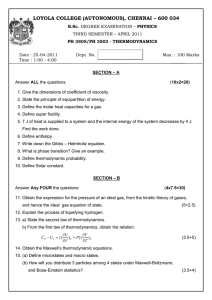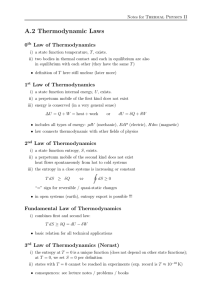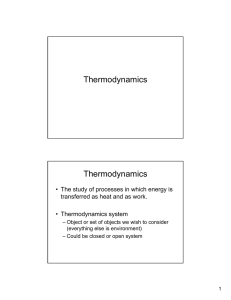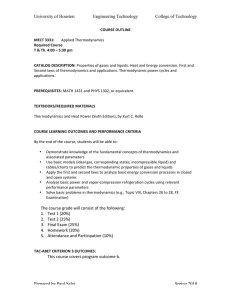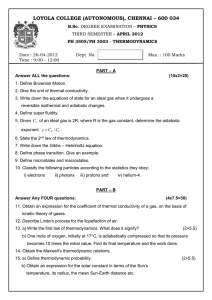Course Assessment Report College of Engineering, The University of Iowa I.
advertisement
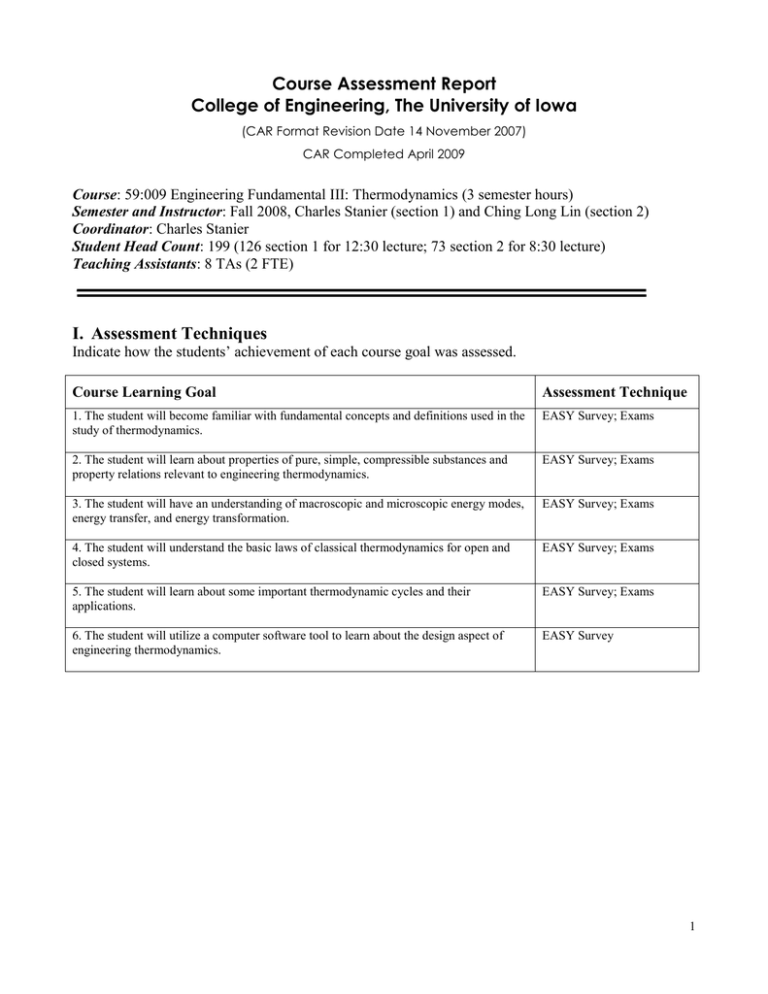
Course Assessment Report College of Engineering, The University of Iowa (CAR Format Revision Date 14 November 2007) CAR Completed April 2009 Course: 59:009 Engineering Fundamental III: Thermodynamics (3 semester hours) Semester and Instructor: Fall 2008, Charles Stanier (section 1) and Ching Long Lin (section 2) Coordinator: Charles Stanier Student Head Count: 199 (126 section 1 for 12:30 lecture; 73 section 2 for 8:30 lecture) Teaching Assistants: 8 TAs (2 FTE) I. Assessment Techniques Indicate how the students’ achievement of each course goal was assessed. Course Learning Goal Assessment Technique 1. The student will become familiar with fundamental concepts and definitions used in the study of thermodynamics. EASY Survey; Exams 2. The student will learn about properties of pure, simple, compressible substances and property relations relevant to engineering thermodynamics. EASY Survey; Exams 3. The student will have an understanding of macroscopic and microscopic energy modes, energy transfer, and energy transformation. EASY Survey; Exams 4. The student will understand the basic laws of classical thermodynamics for open and closed systems. EASY Survey; Exams 5. The student will learn about some important thermodynamic cycles and their applications. EASY Survey; Exams 6. The student will utilize a computer software tool to learn about the design aspect of engineering thermodynamics. EASY Survey 1 II. Course Goals and Program Outcomes Course Learning Goal Program Outcome 1. The student will become familiar with fundamental concepts and definitions used in the study of thermodynamics. 2. The student will learn about properties of pure, simple, compressible substances and property relations relevant to engineering thermodynamics. 3. The student will have an understanding of macroscopic and microscopic energy modes, energy transfer, and energy transformation. 4. The student will understand the basic laws of classical thermodynamics for open and closed systems. 5. The student will learn about some important thermodynamic cycles and their applications. 6. The student will utilize a computer software tool to learn about the design aspect of engineering thermodynamics. a(●), e(●) a(●), e(●) a(●), e(●) a(●), e(●) a(●), e(●), j(○) c(○), g(○), j(○), k(○) Notes: ○ denotes moderate contribution to the outcome ● denotes substantial contribution to the outcome III. Program Outcomes (provided for reference). New graduates from the College of Engineering Undergraduate Programs will have: (a) an ability to apply knowledge of mathematics, science, and engineering (b) an ability to design and conduct experiments, as well as to analyze and interpret data (c) an ability to design a system, component, or process to meet desired needs within realistic constraints such as economic, environmental, social, political, ethical, health and safety, manufacturability, and sustainability (d) an ability to function on multi-disciplinary teams (e) an ability to identify, formulate, and solve engineering problems (f) an understanding of professional and ethical responsibility (g) an ability to communicate effectively (h) the broad education necessary to understand the impact of engineering solutions in a global, economic, environmental, and societal context (i) a recognition of the need for, and an ability to engage in life-long learning (j) a knowledge of contemporary issues (k) an ability to use the techniques, skills, and modern engineering tools necessary for engineering practice. 2 IV. Assessment Log of Recent Changes and Improvements. This section contains a running account of course improvements, including the motivation for the changes. Fall 2008. (Stanier, Lin) Only minor changes in the course relative to spring 2008 and fall 2007. Wiley Plus was not used. One guest lecture was given (Milster Ferman on UIowa Powerplant). The powerplant tour was done, but not for extra credit, and attendance was very low (15-20 students) compared to F07 (144 students) and F06. One design project (in groups) focused on the powerplant given at the end of the semester. Spring 2008. (Lin) Three design-oriented problems were given at the end of the semester. These problems required use of Interactive Thermodynamics (IT) to examine the efficiencies of three different thermodynamic cycles by varying a number of control parameters. Fall 2007. (Stanier, Ratner) Only minor changes in the course relative to fall 2006. New 6th edition of Moran and Shapiro was used for the first time. “WileyPlus” online content feature option required but problems in timeliness (of its delivery from Wiley) and use. Two guest lectures were given (Milster Ferman on UIowa Powerplant, Alec Scranton/David Murhammer on Energy and Society. Spring 2007 (Beckermann) Six 15-minute unannounced quizzes were given. An extensive final design problem was given, as well as six open-ended problems from the Moran & Shapiro text, each requiring ~4 pages of written response. Continuation of open-ended problems and quizzes recommended. (Note, in the fall semester, in-class quizzes are not used since the course is offered in two separate sections). Fall 2006. (Stanier, Ratner) Guest lectures were given (Milster Ferman on UIowa Powerplant, Iowa State researcher on biodiesel); the powerplant tour program was continued from Fall 2005. Spring 2006 (Ratner) Course was maintained similar to Fall 2005. Guest lectures and the power plant were again popular and the students were excited about seeing real-world applications of the topics they are studying. Fall 2005. (Ratner, Stanier) Design problem scaled back to two (one writing and research / one calculation-based) relative to fall 2004. Guest lectures introduced. Voluntary program of powerplant tours started to followup on high interest level of students in Milster Ferman lecture. A tablet PC was introduced. Elluminate Live software was used to record tutorials on the IT software – so that more students would have access to a detailed problem solving demos using the IT software. Spring 2005 (Beckermann) Fall 2004. (Ratner, Stanier) Minor changes relative to previous semesters. Three “design problems” (involving a mix of outside reading, guided computations, and open ended problem solving) were used in the course, with students selecting from multiple topics to try to interest students from multiple disciplines. Motivation was to bring more realistic problems to the students, and give more choices to interest electrical and biomedical engineering students. 3 Historical log of mean EASY scores Offering F2008 S2008 F2007 S2007 F2006 F2005 Goals 1-5 (non software) 5.24 to 5.47 5.07 to 5.43 5.03 to 5.45 5.33 to 5.67 5.05 to 5.38 4.45 to 4.98 Goal 6 (software) 4.53 4.18 4.29 4.83 4.73 4.42 Part A. Improvements and Recommendations this Semester. Provide a description of course improvements that have occurred this semester relative to those of previous semester (including the motivation for these changes), and recommended changes for upcoming semesters as needed. No course improvements were introduced in F2008. WileyPlus was not used, but should be considered as a means to offer some (e.g. 1/3) of the homework problems online and cut down on grading time. Having the powerplant tour as optional and for zero credit yielded low attendance. A method of achieving higher attendance is needed if this is to continue in the future. Student feedback on the tour was positive in previous years, but no comments on the tour this time. In F2007, two course goals (#4 understand/apply thermodynamic laws to open and closed systems; #5 thermodynamic cycles) were not met and the recommendation was to structure exams in a way to better assess exposure vs. competency. This was achieved in F2008. In future semesters, homework problems with IT use should be examined for assessment, or the design project should include a greater use of IT software. Part B. Quantitative Assessment Results. Provide a quantitative assessment for each course learning goal. Quantitative Assessment Method: Self-assessment results and exams were used to provide independent assessment of achievement of course learning goals. Self-assessment based method: Each learning goal was assessed using questions phrased as “I learned the concepts….” and a 1-6 response scale: 6 strongly agree; 5 moderately agree; 4 slightly agree; 3 slightly disagree; 2 moderately disagree; 1 strongly disagree. Mapping scores of 5-6 to mastery; 3-4 to competency; and 1-2 to exposure. Exam-based method: Problem-specific exam scores were recorded for 2 of the 3 midsemester exams and the final. Problems were mapped to 1 or 2 learning goals, and then a weighted average for each student and each learning goal was calculated. These were binned to mastery (>85%), competency (50-85%), and exposure (<50%). Students receiving an F in the course are not included in the calculations. (The mastery bin changed relative to F2007 based on recommendation of curriculum committee that mastery should reflect “A” performance, not A/B performance). 4 In either case, a course learning goal was considered as NOT met if the “exposure” fraction of the class was higher than 30% in either the self-assessment or exam based metric. This is higher than the 10% threshold applied in some departmental classes, but is justified given the broad spread of majors. Quantitative Assessment Results – Self-Assessment Based: 72 students completed the online survey administered by the college of engineering. Each learning goal was assessed using questions phrased as “I learned the concepts….” and a 1-6 response scale: 6 strongly agree; 5 moderately agree; 4 slightly agree; 3 slightly disagree; 2 moderately disagree; 1 strongly disagree. Mapping scores of 6 to mastery; 3-5 to competency; and 1-2 to exposure. This is a change in the master/competency split to reflect guidance from curriculum committee that master should reflect A performance. Using this metric, the learning goals fall into 2 categories. The first category contains learning goals 15 and the fraction of students falling into mastery ranges from 46-61% (varies by learning goal); into competency (36-50%), and exposure 3-4%. Learning goal 6 (software) was different with a breakdown of mastery (29%); competency (62%); and exposure (9%). This is consistent with historically low self assessment given around the IT software package, which requires simple command line programming, has some bugs, and can be difficult at times. EASY Survey Questions I learned the definitions and underlying concepts of thermodynamic terms such as system, property, state, phase, process and cycle. I learned about the concepts of energy transfer by heat and work, and energy transformation from one form to another. I learned how to determine properties for pure, simple, compressible substances, and the relations between these properties. I learned the basic laws of classical thermodynamics for closed and open systems. I learned about some important thermodynamic cycles and their applications. I learned to utilize Interactive Thermodynamics software to compute thermodynamic properties and solve thermodynamics problems. I learned to use IT software to vary parameters in a thermodynamic process or cycle to see the effect on the operation of the process/cycle, thus allowing for the design optimization of the process/cycle. Course goals Mean/Median 1 5.42/6.00 3,4 5.47/6.00 2 5.24/5.00 4 5.37/6.00 5 5.38/6.00 6 4.56/5.00 6 4.50/5.00 Quantitative Assessment Results – Exam Based: Summary: The results show good to excellent achievement of course goals 1 (concepts) and 5 (cycles), with exposure at less than 10% of the class. The remainder of the course goals (2-4) were intermediate with exposure ranging between 10 and 25%. The threshold for attainment of a course goal is 25%, therefore all course goals were met. However, goals 2 (properties) and 3 (energy transformation in form of work and heat) were borderline. Goal 2 (properties) involving steam tables, phase diagrams, and the ideal gas law is historically problematic. What is encouraging is that students did well in 5 course goals 4 and 5 concerning energy calculations and cycles – which require extensive use of properties. In summary, all course goals were met in F2008. Detail: 1. The student will become familiar with fundamental concepts and definitions used in the study of thermodynamics. This was accessed by a weighted average of the following exam questions - E1q3, E2q1, Fq1 On these three questions, students received an average of 75% of available points, with a standard deviation of 15%. The breakdown by mastery / competency / exposure is as follows: M 30% of class C 65% of class E 5% of class Survey-based assessment in this area (described above) was favorable. 2. The student will learn about properties of pure, simple, compressible substances and property relations relevant to engineering thermodynamics. This was accessed by a weighted average of the following exam questions - E1q1, E1q2 On these three questions, students received an average of 64% of available points, with a standard deviation of 21%. The breakdown by mastery / competency / exposure is as follows: M 18% of class C 57% of class E 25% of class Survey-based assessment in this area (described above) was favorable. 3. The student will have an understanding of macroscopic and microscopic energy modes, energy transfer, and energy transformation. This was accessed by a weighted average of the following exam questions - E1q4, E1q5, Fq1 On these three questions, students received an average of 62% of available points, with a standard deviation of 19%. The breakdown by mastery / competency / exposure is as follows: M 10% of class C 66% of class E 24% of class Survey-based assessment in this area (described above) was favorable. 6 4. The student will understand the basic laws of classical thermodynamics for open and closed systems. This was accessed by a weighted average of the following exam questions - E2q2, E2q4 On these three questions, students received an average of 71% of available points, with a standard deviation of 21%. The breakdown by mastery / competency / exposure is as follows: M 33% of class C 50% of class E 17% of class Survey-based assessment in this area (described above) was favorable. 5. The student will learn about some important thermodynamic cycles and their applications. This was accessed by a weighted average of the following exam questions - Fq2, Fq3 On these three questions, students received an average of 71% of available points, with a standard deviation of 21%. The breakdown by mastery / competency / exposure is as follows: M 21% of class C 69% of class E 10% of class Survey-based assessment in this area (described above) was favorable. 6. The student will utilize a computer software tool to learn about the design aspect of engineering thermodynamics. This was accessed survey alone (exams are paper-and-pencil). See above for assessment result. In summary, M 29% of survey respondents C 62% of survey respondents E 9% of survey respondents Graded design projects were examined for use of software. Highest scored design projects had excellent software proficiency demonstrated. But mid and lower scores either had poor proficiency or left the software portion of the design problem uncompleted. Because the project was not weighted too heavily in the course, and the software component was a small fraction on the overall project, some students did not complete that portion of the project. 7 Course Outcomes Worksheet (COW) 59:009 Engineering Fundamental III: THERMODYNAMICS C. Stanier Course Activity Three class hours at the beginning of the semester introduce the students to the fundamental concepts and definitions in thermodynamics. Six class hours are spent on properties of pure substances and the ideal gas law. Basis for Course-Goal Assessment EASY survey assessment by students and instructor; graded copies of exam questions. A (●), E (●) Three class hours are spent on introducing the concepts of work and heat. EASY survey assessment by students and instructor; graded copies of exam questions. A (●), E (●) Ten class hours are spent on the First Law and eleven class hours are spent on the Second Law of thermodynamics. Six class hours are spent on cycles. EASY survey assessment by students and instructor; graded copies exam questions. Course Goals Supports ABET Outcomes 1. The student will become familiar with fundamental concepts and definitions used in the study of thermodynamics. A (●) , E (●) 2. The student will learn about properties of pure, simple, compressible substances and property relations relevant to engineering thermodynamics. 3. The student will have an understanding of macroscopic and microscopic energy modes, energy transfer, and energy transformation. 4. The student will understand the basic laws of classical thermodynamics for open and closed systems. 5. The student will learn about some important thermodynamic cycles and their applications. 6. The student will utilize a computer software tool to learn about the design aspect of engineering thermodynamics. A (●), E (●) A (●), E (●) , J (○) C (○), G (●), J (○), K (○) ○ denotes moderate contribution to the outcome Students use the Interactive Thermodynamics software to complete a design project, involving contemporary issues in thermodynamics, and write a final report. ● denotes substantial contribution to the outcome EASY survey assessment by students and instructor; graded copies of exam questions. EASY survey assessment by students and instructor; graded copies of exam questions. EASY survey assessment by students and instructor; graded copies of the homework. 8 Identifier A. B. C. ABET Outcomes They will have the ability to apply knowledge of mathematics, science and engineering in their chosen fields. They will have the ability to design and conduct experiments, and to analyze and interpret experimental results. They will have the ability to design systems, components, or processes to meet specified objectives in their chosen fields. D. E. F. G. H. They will have the ability to work as members of multidisciplinary project and/or research teams, and have an understanding of leadership in teams and organizations. They will have the ability to identify, formulate, and solve engineering problems. They will have an understanding of professional and ethical responsibility and the value of mentorship and peer support. They will have the ability to communicate effectively in oral, written, and graphical forms. They will have an education that is supportive of a broad awareness of the diversity of the world and its cultures, and that provides an understanding of the impact of engineering practice in the global community. I. J. K. They will understand the importance of updating and maintaining their technical skills and continuing their education throughout their professional careers. They will have a knowledge of contemporary issues They will have the ability to use the principles, techniques, skills and modern engineering tools necessary for successful engineering practice and/or research in their chosen fields. 9 EASY Faculty/Student Assessment Questions 59:009 Engineering Fundamental III: THERMODYNAMICS Fall 2004 Question Course No. Goal 2 1 4 3 6 2 8 10 12 4 5 6 14 6 EASY Assessment Statement I learned the definitions and underlying concepts of thermodynamic terms such as system, property, state, phase, process and cycle. I learned about the concepts of energy transfer by heat and work, and energy transformation from one form to another. I learned how to determine properties for pure, simple, compressible substances, and the relations between these properties. I learned the basic laws of classical thermodynamics for closed and open systems. I learned about some important thermodynamic cycles and their applications. I learned to utilize Interactive Thermodynamics software to compute thermodynamic properties and solve thermodynamics problems. I learned to use IT software to vary parameters in a thermodynamic process or cycle to see the effect on the operation of the process/cycle, thus allowing for the design optimization of the process/cycle. 10 Fall Semester, 2008 COURSE ORGANIZATION Course: Lecture: Web Site: Instructor: 59:009 Engineering Fundamentals III: Thermodynamics Section 1, Stanier, 12:30P - 1:20P MWF 1505 SC Section 2, Lin, 8:30A - 9:20A MWF 1505 SC http://icon.uiowa.edu/ Ching-Long Lin, Professor Dept. of Mechanical and Industrial Engineering 2406 Seamans Center ching-long-lin@uiowa.edu Charles Stanier, Assistant Professor Dept. of Chemical and Biochemical Engineering 4122 Seamans Center charles-stanier@uiowa.edu Teaching Assistants: Andrew Lambert (head TA): arlamber@engineering.uiowa.edu Jiwoong Choi: jiwchoi@engineering.uiowa.edu Haribalan Kumar: hkumar@engineering.uiowa.edu Youbing Yin : youbing-yin@uiowa.edu Allison Bartak: abartak@engineering.uiowa.edu Min Huang : min-huang-1@uiowa.edu Haihan Chen : haihan-chen@uiowa.edu (grader) Co-/Pre-requisites: 22M:032 Eng. Math II; 4:011 Princ. Chem. I, 29:081 Intro. Phys. I Textbook: Moran, M.J. and Shapiro, H.N., Fundamentals of Engineering Thermodynamics, 6th Edition, John Wiley and Sons. Office Hours: See the consultation schedule. Grading: 1. Homework and Participation 2. Hour Exams (3) 3. Final Exam 25.0% 50.0% 25.0% 100.0% “Homework and Participation” will include points for standard homework assignments, design problems, and guest lecture attendance. Letter grades are determined by two methods (see below) and students earn the higher of the two grades. No grades will be dropped. 11 Method 1. Fixed performance targets: Overall score of 83 and higher will earn an A ( A-, A or A+ depending on performance ) Overall score of 70 or higher will earn at least a B ( specifically, a B- or higher, depending on performance) Overall score of 61 or higher will earn at least a C ( C- is not included. In other words, a C, C+ or better ) Overall scores lower than 61 will be graded using the curve Method 2. On a curve centered on a B Course Objectives: 1. Develop a basic understanding and knowledge of thermodynamics and its application to engineering, 2. Learn about energy and its conversion from one form to another, 3. Learn about properties of substances, 4. Learn the basic laws of thermodynamics and their applications, and 5. Develop a methodology for solving problems. Course Outline: 1. Introduction and Definitions 2. Properties, Energy, Zero-th Law of Thermodynamics 3. First Law of Thermodynamics (conservation of energy) 4. Second Law of Thermodynamics (restrictions on energy transfer) 5. Entropy 6. Introduction to Power and Refrigeration Cycles and Psychrometrics Homework Assignments: See 59:009 Syllabus for daily reading and homework assignments. Homework problems are due at 4:30 p.m. on the day indicated. No late assignments will be accepted. Students are required to follow the following guidelines/rules in preparing their homework: 1. Work the problem out on scratch paper first and then copy your final solution to engineering paper. Homework will not be graded if it is not on engineering paper. 2. At the top of the first sheet, place the course number and title, problem number, date, your name (last, first), and the page/total pages. 3. 4. Start each problem on a new sheet. Be neat and logical. All straight lines appearing in sketches and graphs should be drawn with a ruler. 5. The final answer(s) should be boxed. 6. All work should be done using standard SI units. The final answer(s) should be presented in SI units. 7. Students are responsible regarding proper use of significant digits and unit symbols in the final answer. 8. Students may work problem assignments together but each must submit an independent write-up for grading. Usually the homework assignments will consist of two or three problems all of which must be submitted for grading. Only one problem will be graded and the grade of this problem will be recorded. 12 The homework problems that require using the Interactive Thermodynamics (IT) software are denoted by IT in the syllabus. IT is installed on the CSS PC workstations. Click on Start, All Programs, Engineering Software, then Interactive Thermodynamics. The answers to all problems will be provided. The homework format is given in the text and in the APPENDIX to this handout. Homework can be handed in during class or placed in the box across from 2402 SC. The homework will be graded within two days and may be picked up in Room 2258 SC during the consultation hours. Homework solutions will be posted on the class web site. Hour and Final Examination Policies and Procedures Hour and final examinations will be given at the times and in the rooms indicated in the syllabus. Hour and final examinations will be open-book. Calculators may be used during the examinations. No questions will be answered during examinations. If a student is uncertain about an exam question, he/she should use reasonable engineering judgment, state assumptions being made, and proceed to solve the problem utilizing the assumptions made. SI system will be employed in examination questions. Homework format should (highly recommended) be followed on examination problems. No penalty on significant figures unless absurd values are given. If a problem requires sketching, a process or diagram, it must be carefully constructed and fully labeled. Show all work in exam booklet for full credit. Problem Solution Procedure: The methodology outlined in the APPENDIX (and in text) will be used in this course. The use of this methodology will help you find the final solution in the quickest time with the minimum errors. To add incentive, this methodology must be followed when solving homework problems and exam questions to receive full credit. In addition, the consultation room personnel will ask to see your attempted solution when you approach them with a question, and will go over the methodology to see how far you have progressed. Thermodynamics Consultation Room/Office Hours: Room 2258 SC is the Thermodynamics Consultation Room. The schedule will be provided to each student and posted on the class web site. Students may use the consultation room at any of the scheduled times. Students can arrange other meetings with the class instructor at a mutually agreed upon day and time. When you seek help on a specific problem, the instructor or assistant will ask to see your attempted solution. If you have not done any basic analysis (e.g., define the problem and identify the thermodynamic system, identify the basic equations), you will not get help. The instructor or teaching assistants are not there to provide easy answers, but to assist you in the process of learning thermodynamics. Student Performance 13 Updated grades on homework assignments and on examinations will be posted on the class web site so that students can verify the correctness of the recorded data as well as assess her/his performance to date. Appendix: Solution Methodology KNOWN: State problem briefly in your own words; do not repeat statement from text. FIND: Indicate what must be found. THERMODYNAMIC SYSTEM AND PROCESS: 1. Sketch system a. Identify system boundaries by a dashed line and indicate whether it is a control mass or a control volume. b. Identify the Energy Transfer Processes (heat, work); draw arrows to indicate relevant processes and their assumed direction. c. Show system properties or conditions provided in problem statement on the sketch. 2. Sketch the thermodynamic process on the pertinent process diagram showing, if possible, the following items: a. Initial state b. Final state c. Process line(s) ASSUMPTIONS: List all pertinent simplifying assumptions. PROPERTIES: Compile property values needed for subsequent calculations and identify table from which they are obtained. ANALYSIS: 1. Begin the analysis by introducing the relevant basic equations and then reducing them to their appropriate form based upon the stated assumptions. 2. Solve for the desired quantity. Note that when manipulating equations, it is better, easier, and faster to work with alphabetical characters. 3. Substitute numerical values and perform calculations to obtain desire results. Check units. 4. Clearly label your answer, with units, by a box. Report only significant digits. See your text for the proper unit abbreviations (e.g., MPa, kPa) COMMENTS: Carefully review your solution procedure and provide brief comments on the results. Some possible questions to answer are 1. What principles were involved? 2 . Based upon physical insight, check the following: Are the directions of heat and work correct? Is the magnitude of the quantity reasonable? Were the assumptions reasonable? 3 Are the results consistent with the process diagram? 14 Syllabus for 59:009 Thermodynamics (Fall 2008) Class 1 2 3 4 5 6 7 8 9 10 11 12 13 14 15 16 Date 25-Aug 27-Aug 29-Aug 1-Sep 3-Sep 5-Sep 8-Sep 10-Sep 12-Sep 15-Sep 17-Sep 19-Sep 22-Sep 24-Sep 26-Sep 29-Sep 1-Oct Thur 2-Oct 17 18 19 20 21 22 23 3-Oct 6-Oct 8-Oct 10-Oct 13-Oct 15-Oct 17-Oct 20-Oct Tue 21-Oct 24 25 26 27 28 29 30 31 32 33 34 35 36 22-Oct 24-Oct 27-Oct 29-Oct 31-Oct 3-Nov 5-Nov 7-Nov 10-Nov 12-Nov 14-Nov 17-Nov 19-Nov Th Nov 20 21-Nov 37 38 39 40 41 42 15 1-Dec 3-Dec 5-Dec 8-Dec 10-Dec 12-Dec 15-Dec Topic Introduction Definitions Definitions First Law First Law First Law First Law First Law First Law Properties Properties Properties Properties Properties Review EXAM #1 no class First Law First Law First Law First Law First Law First Law Review Exam #2 2nd Law 2nd Law 2nd Law 2nd Law Entropy Entropy Entropy Entropy Entropy Entropy Entropy Entropy Review Exam #3 Text Handouts 1.1, 1.2, 1.3 1.4, 1.5, 1.6, 1.7 no class – University holiday 2.1, 2.2 KE, PE 2.2 Work 2.3, 2.4 Energy, Heat 2.5 Closed Systems 2.6 Cycles 2.6 and IT software 3.1 State Principle 3.2 p-v-T Guest lecture 3.3 Data, Tables, IT 3.3 Data, Tables 3.5-3.8 Ideal Gas Model Chapters 1 to 3 8:00 – 10:00 PM 4.1 Mass Conservation 4.2 Energy Conservation 4.2 Nozzle, Diffuser 4.3 Turbine 4.3 Compressor, Pump 4.3 Heat Exchanger, Throttle Chapter 4 8:00 – 10:00 PM 5.1 2nd law 5.2 Irreversibility 5.3 Cycles 5.5, 5.6 Max. efficiency, Carnot 6.1, 6.2 Clausius, Entropy 6.3 Entropy Data 6.3, 6.4 Internally Reversible 6.5 Entropy Balance, Closed 6.6 Entropy Balance, Open 6.7 Isentropic Process 6.8 Isentropic Efficiency 6.9 Heat and Work Chapters 5 and 6 8:00 – 10:00 PM no class THANKSGIVING BREAK Cycles 8.1, 8.2 Rankine cycle Cycles 8.2, 9.1 Rankine/Otto cycles Cycles 9.1, 9.2, 9.3 Otto/Diesel cycles Cycles 9.3, 10.1 Diesel/Vapor Ref. cycles Cycles 10.1, 10.2 Vapor Refrig. cycle Review FINAL EXAM 4:30 – 6:30 PM H.W. Due 1.2, 1.15 1.27, 1.34 2.7, 2.15 2.18, 2.25 2.32, 2.36 2.43, 2.62 2.57, 2.74 handout – see ICON 3.1, 3.6 3.10, 3.12, IT-3.41a 3.30, 3.49, IT-3.65 handout – see ICON 225 CB 4.5, 4.16 4.23, IT-4.36 4.31, 4.38 4.43, 4.50 4.59, 4.63 4.74, 4.95 225 CB 5.1, 5.4 5.17, 5.36 5.60, 5.77 5.81, 5.85 6.3, 6.7 IT-6.9(a), 6.11 6.21, 6.24 IT-6.47, 6.66 6.117, 6.122 6.143, 6.146 6.82, 6.104 LR1 & LR2 VAN 8.6, IT-8.8 8.13, 8.20 IT-9.1, 9.2 9.28, IT-9.32 10.8, 10.15 Location to be announced


